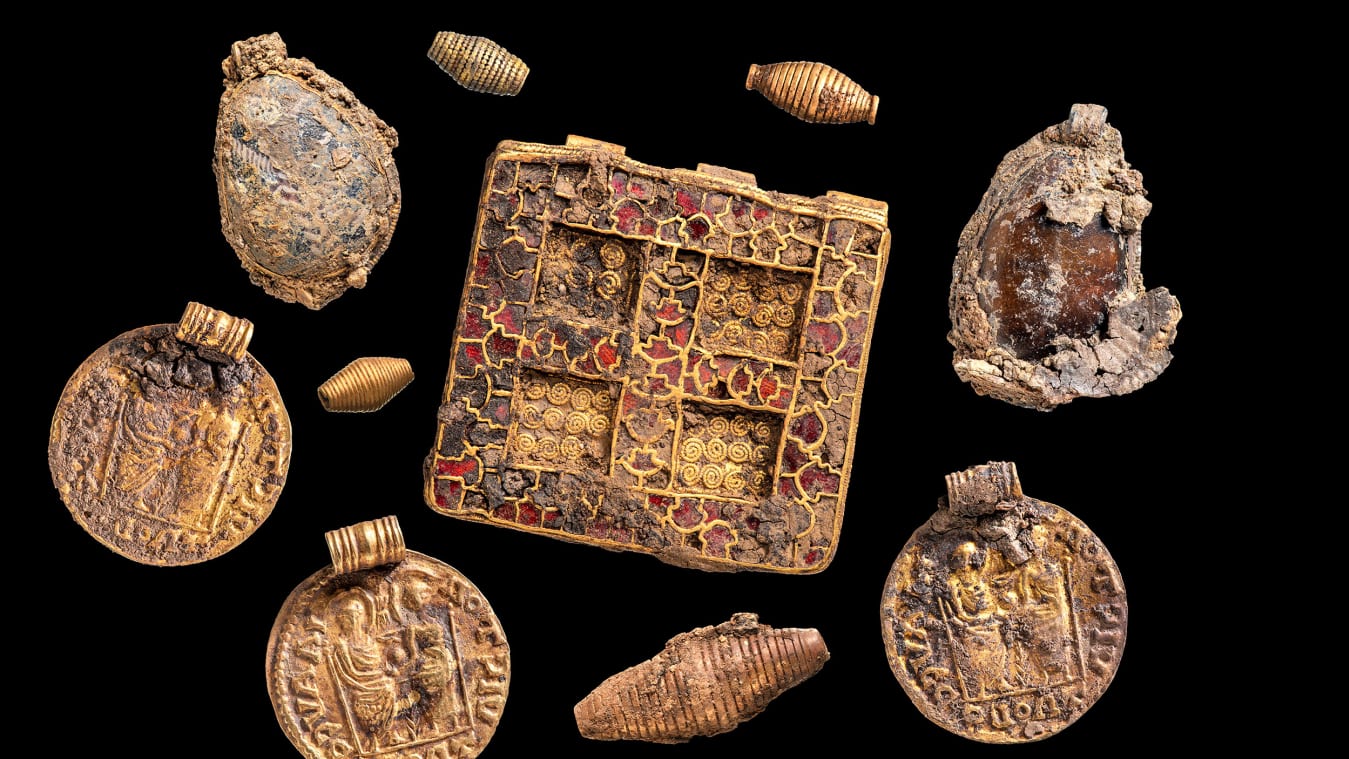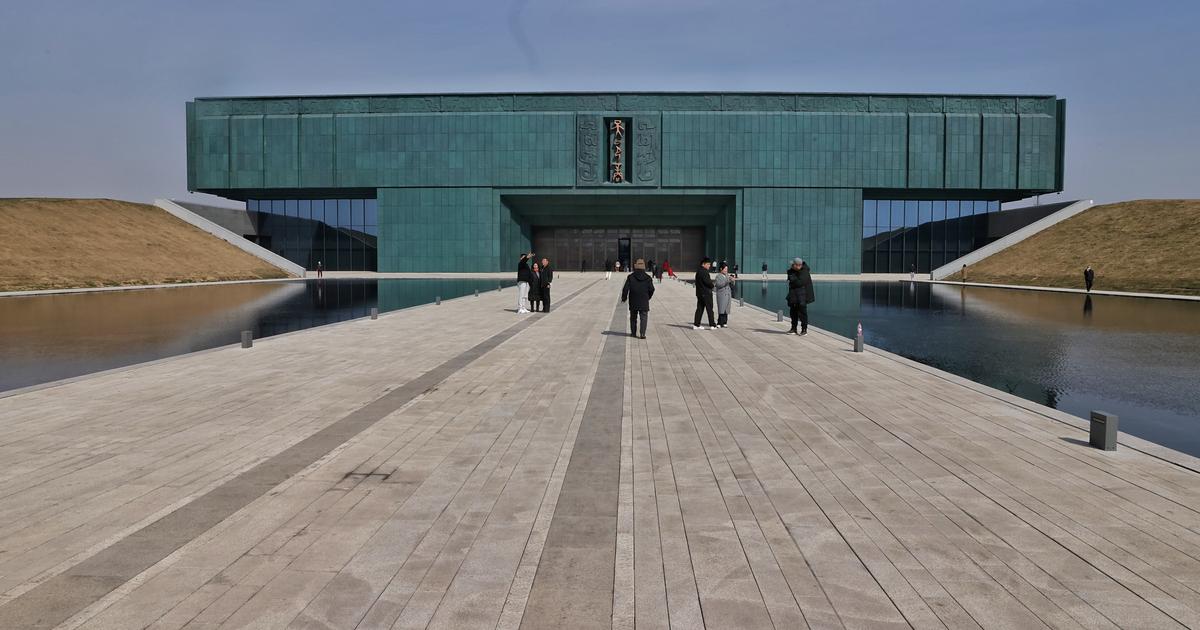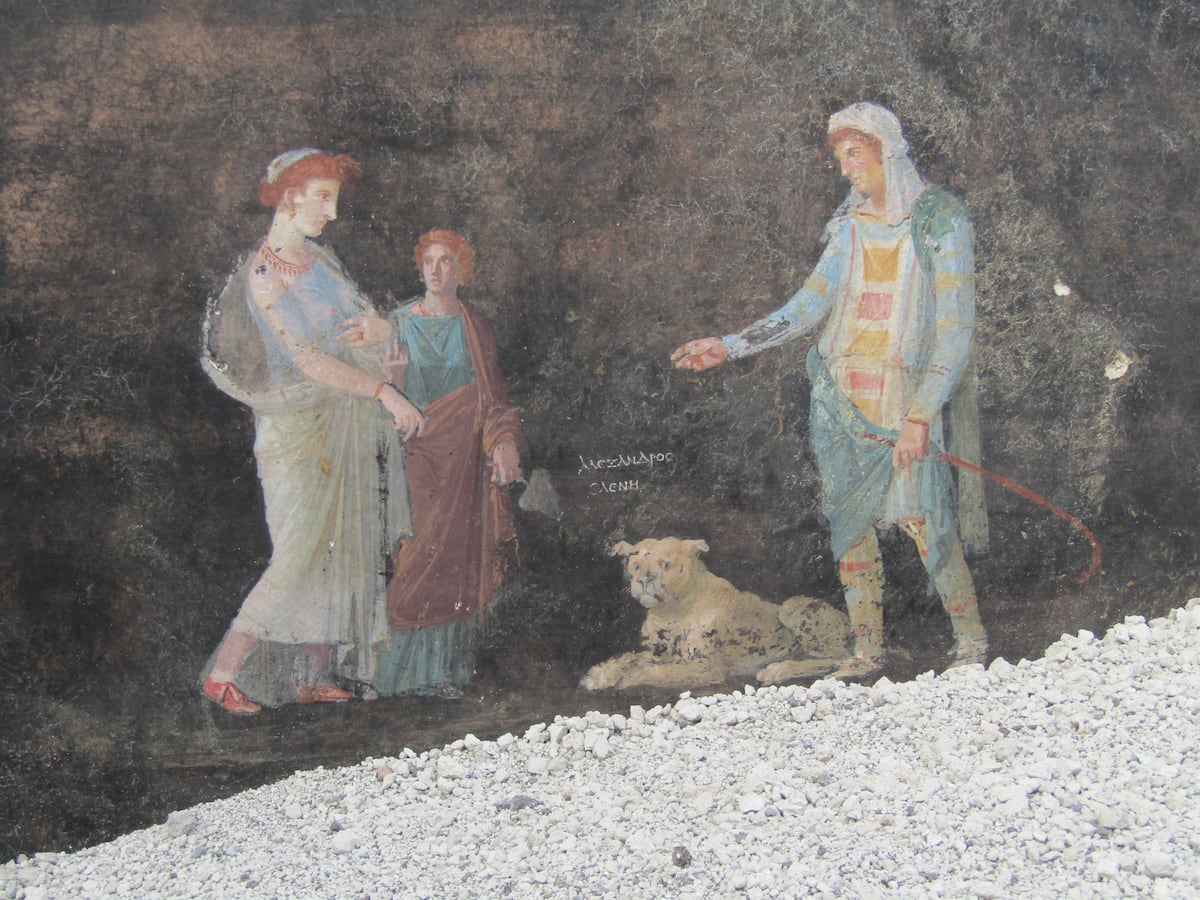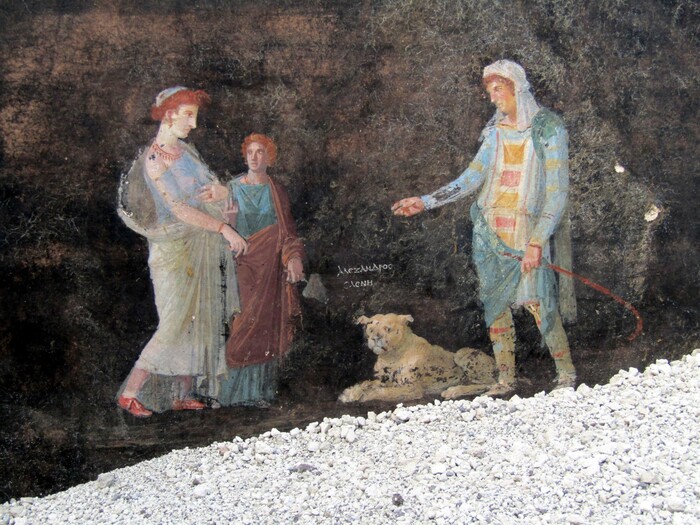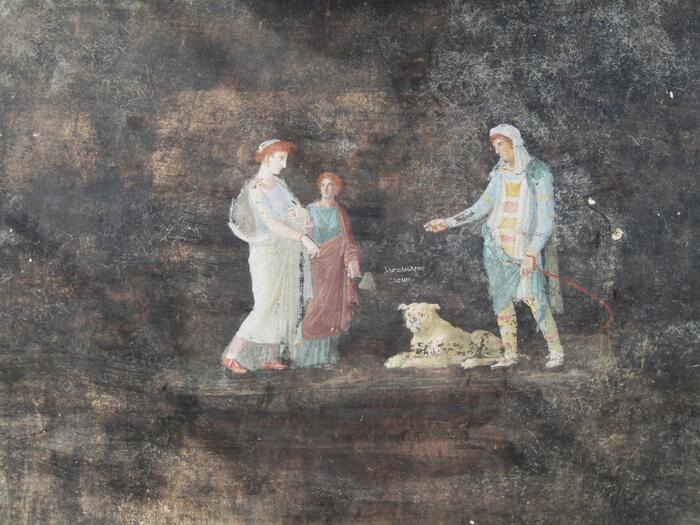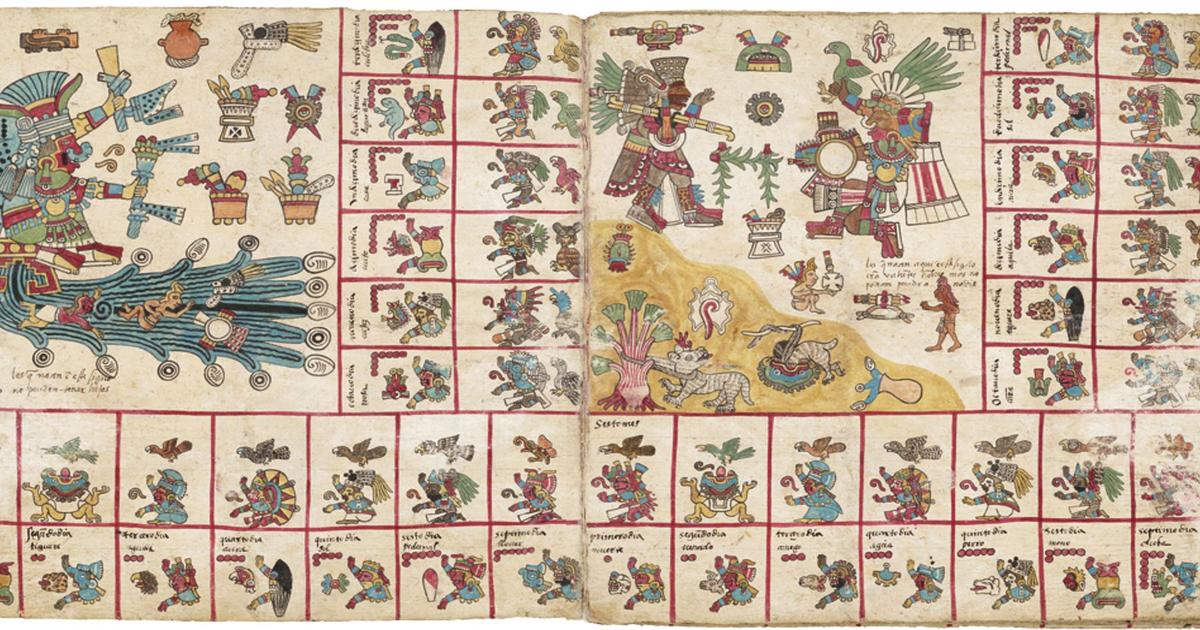Pieces of a necklace from an influential Anglo-Saxon woman.
(CNN) --
We may dream of winning the lottery, but what if we found a medieval wedding ring in our garden or a Byzantine mosaic on our farm?
Archaeologists and art curators have joined with ordinary people to come up with some of the most exciting discoveries of the year.
Among them, a Van Gogh self-portrait hidden behind a painting, a vast buried Roman city, and a secret tunnel to what could be Cleopatra's lost tomb.
Below, the most interesting artistic and archaeological discoveries of 2022.
An ancient method of punishment for "naughty students" resurfaces
When ancient Egyptian youths were disciplined with lines of writing 2,000 years ago, they probably didn't expect their efforts to survive long enough for us to see.
Hundreds of these tablets were found, with the same symbol normally written on both the front and back.
Credit: Athribis-Project Tübingen
But archaeologists discovered 18,000 pieces of inscribed pottery — known as "ostraca" — at the Athribis archaeological site earlier this year, and among them were hundreds of shards with a single symbol repeated on the front and back.
According to researchers from the German University of Tübingen, which carried out the excavation, these scribbles are proof that "naughty students" were forced to write lines;
in other words, the “Bart Simpsons” of the Nile Valley. The fragments also included receipts, school texts, business information, and lists of names.
A possible clue about Cleopatra's lost tomb
Discovering Cleopatra's lost tomb would be a "holy grail" for archaeologists, and a team from the University of Santo Domingo may have found its entrance.
In November, the Egyptian Ministry of Tourism and Antiquities announced that the team had located a 1,305-meter-long tunnel, located more than 13 meters underground, at an archaeological site around a temple in the ruined city of Taposiris Magna, during an extensive search for the burial place of the former sovereign.
advertising
A network of tunnels under the temple of Taposiris Magna could lead to Cleopatra's last resting place.
Credit: Khaled El-Fiqi/EPA/Shutterstock
So far, the excavation in Egypt has brought to light more than 1,500 objects, including statues and coins, according to archaeologist Katherine Martinez, who spoke to CNN, but "the most interesting discovery is the complex of tunnels that lead to the Mediterranean Sea and the sunken structures", which they will continue to excavate.
Van Gogh peeks into a hidden portrait
The world now knows one more Van Gogh self-portrait and it was hidden behind a painting of a peasant girl.
Scottish art conservators made the discovery by taking an X-ray of one of his 1885 portraits and uncovering the artist's own face behind layers of cardboard and glue.
Although X-rays often reveal how artists modified their compositions, the Dutch artist's full-length self-portrait came as a huge surprise.
Van Gogh was known for reusing canvas to save money, according to the National Galleries of Scotland (NGS), where the discovery was made.
X-ray of Van Gogh's self-portrait together with the artwork that hides it.
Credit: Neil Hanna
"Moments like this are incredibly rare," Frances Fowle, NGS's chief curator for French art, said in a press release announcing the news.
Whether the self-portrait can be safely separated from the painting remains to be seen, as conservators continue to study the work.
A romantic sample found by mere luck
An English country man trying to become a metal detectorist stumbled across a medieval gold and diamond wedding band on his second try.
David Board's astonishing find -- which he first believed to be "junk," he told CNN -- was made in 2019, but came to public attention this fall before its sale at Noonans.
A metal detectorist found this gold and diamond ring on his second try.
Credit: Noonans
The piece of jewelry features two intertwined bands to symbolize the marital union and an inverted diamond.
Inside the band is a medieval French inscription that reads: "Ieo vos tien foi tenes le moy," which translates to "I hold your faith, hold mine," according to the auction house.
The ring sold for 38,000 pounds ($46,000) on November 29.
A thermal bath reveals its ghosts
This fall unexpected guests turned up at a Tuscan thermal bath: more than two dozen well-preserved ancient Roman bronze statues covered in nearly 6,000 coins.
Italy hails 'exceptional' discovery of ancient bronze statues in Tuscany
The statues, which represent Greco-Roman divinities such as Apollo and Hygieia, were discovered in the town of San Casciano dei Bagni, in the province of Siena.
For three years, archaeologists have been digging in the quagmire of an old bathhouse.
A 2,300-year-old bronze statue, one of two dozen found in ancient thermal baths in Tuscany.
Credit: Minister of Culture/Reuters
Jacopo Tabolli, an adjunct professor at the University for Foreigners of Siena who coordinated the excavation, explained that the statues were intentionally submerged underwater as a ritual gift, sometime between the 2nd century BC and 1st century AD.
"You offer to the water because you expect the water to give you something back," he explained to Reuters at the time.
A simple mirror reveals an amazing secret
A modest bronze mirror kept at the Cincinnati Museum of Art turned out to be an incredibly rare object with a "magical" secret: when light is shone directly on it, the image of a seated Buddha emerges.
A 400-year-old "magic mirror" reveals the image of a Buddha when light falls on it in a certain way.
Photo: Rob Deslongchamps/Cincinnati Museum of Art
The museum's curator of East Asian art, Hou-mei Sung, made the discovery in 2021 on a hunch, after noting that the mirror resembled other examples of "magic mirrors" from Edo-period Japan.
She and a conservator shined a cellphone flashlight on the object, first showing a nondescript image with some texture on the wall in front of them.
After experimenting with more focused lights, a sharp image emerged of Amitabha, whose name is inscribed in Chinese on the reverse.
"We were very excited," Sung told CNN in July, when the museum announced his find.
Only a few institutions in the world have a magic mirror in their collections.
Researchers rethink a famous Vermeer
What makes a Vermeer a Vermeer?
When researchers conducted an exhaustive study of several notable paintings by the Dutch master Johannes Vermeer, they discovered that one of them -- "Girl with a Flute" -- was actually misattributed, or a forgery.
It is likely that the painting was made in his studio, either by an assistant, an apprentice, or a relative.
"Girl with a Flute" may have been painted by an assistant to Vermeer or a member of his family.
Credit: National Gallery of Art
Marjorie Wieseman, head of Northern European paintings at the National Gallery of Art in Washington, who has exhibited the finds in the "Secrets of Vermeer" show, told The Art Newspaper that the portrait may actually have been the work of Vermeer's daughter. The artist's eldest, Maria.
They find a huge pink diamond in the mines of Angola
This summer, Australian miner Lucapa Diamond Company announced that it may have found the largest pink diamond in 300 years.
The 170-carat, pink-tinted gem, dubbed "Rosa de Lulo", was found in Angola and the government hailed it as a "historic" discovery.
This pink diamond may be the largest discovered in 300 years.
Credit: Lucapa Diamond Company
Pink diamonds, rarer than white, have been known to fetch exorbitant prices at auction.
The 11.15-carat cut pink diamond, known as the "Williamson Pink Star," sold for nearly $60 million in October, while the "Pink Star Diamond" broke records in 2017 when the strawberry-sized cut stone 59.60 carats sold for more than US$71 million.
At 170 carats, this may be the largest pink diamond found in 300 years.
Unexpected appearance of Hercules
In September, archaeologists completed an excavation that uncovered large pieces of a youthful depiction of the mythological hero Hercules -- also known as Heracles -- in Philippi, northeastern Greece.
Large pieces of a Hercules statue discovered in northeastern Greece.
Credit: Ministry of Culture
The classical statue (dating to the second century AD) was an "extraordinarily interesting" and unusual find, according to Archie Dunn, a professor of Byzantine archeology at the University of Birmingham, who was not involved in the excavation.
The statue, which is presumed to be part of the decoration of a fountain, was a rare ornament at the time, mainly due to its "pagan origins", he explained.
A farmer finds a Byzantine mosaic in Gaza
Last spring, a Palestinian farmer was puzzled when trees failed to take root on a patch of his land, so he and his son started digging and found something totally unexpected.
The intact Byzantine-era mosaic they discovered features colorful animals and intricate drawings, and is located in their olive orchard in the Bureij refugee camp.
A farmer and his son (pictured) discovered this mosaic in Gaza.
Credit: Ibrahim Dahman/CNN
"I searched the internet... We found out it was (a) mosaic from the Byzantine period," the father, Salman al-Nabahin, told Reuters in September.
"I see it as a treasure, dearer than treasure. It is not personal, it belongs to all Palestinians."
Assyrian carvings found after the passage of ISIS
When archaeologists began work to rebuild the razed Mashki Gate, or "Gate of God," in Nineveh, Iraq, which had been destroyed by ISIS militants, they did not expect to find well-preserved ancient Assyrian carvings beneath the ruins.
The excavation team discovered seven marble slabs depicting Assyrian soldiers, palm trees, pomegranates and figs that were part of the palace of King Sennacherib, who ruled from Nineveh around 700 BC and had the gate built.
The reconstruction works of the Mashki Gate made it possible to discover these ancient carvings.
Credit: Zaid al-Obeidi/AFP/Getty Images
"We were all in awe and practically speechless. It was like a dream," archaeologist Michael Danti told CNN in October.
"No one predicted that we would find reliefs of Sennacherib on a city gate."
An Anglo-Saxon jewel of a powerful woman resurfaces
In April, archaeologists discovered the grave of an important woman in the county of Northamptonshire, England, some 13 centuries ago, on land earmarked for a housing development.
She left behind an extraordinary necklace of gold, garnet and other semi-precious stones, along with other objects such as a large silver cross and decorated ceramics.
Necklace of a wealthy woman reconstructed 13 centuries after her burial.
Credit: MOLA/Hugh Gatt
Who was?
The investigation team isn't sure, but they know that she was powerful and devoted, possibly a princess or abbess.
The find joins a dozen similar burials of high-status women that have been found across the country, with some graves including similar necklaces.
A secret chamber reveals ancient art
Approximately five years after looters broke into a secret chamber 100 feet under a house in southeastern Turkey (and were subsequently captured), archaeologists discovered that the Iron Age complex contains ancient works of art that they illustrate important cultural exchanges.
Figurative works from the 9th century BC showing a procession of gods.
Credit: M. Önal
In May, the team shared their findings, detailing an unfinished work of art carved into a rock face from the 9th century BC that shows a procession of deities.
Made during the Neo-Assyrian empire, which began in Mesopotamia and spread outwards, this illustration shows a fusion of cultures rather than conquest, according to the study.
A vast Roman city found in the UK
The construction of HS2, a high-speed rail project in England, has inadvertently led to one of the most exciting discoveries of the year: the remains of a Roman trading settlement near Northamptonshire.
The discovery, in January, included a causeway and more than 30 round houses, as well as workshops, ovens, wells, jewelry, cosmetics, ceramics and more than 300 Roman coins.
Large Roman city and hundreds of artifacts discovered during a railway excavation
Aerial image of the Blackgrounds Roman archaeological site.
Credit: Courtesy of HS2 Ltd
Based on the findings, the site, known as Blackgrounds, is believed to have once been home to a "busy and busy area", according to a press release, with commerce, industry and wealthy residents.
Another treasure of Sanxingdui
Since a farmer's discovery of an artifact-rich area a century ago, now called the Sanxingdui Archaeological Site, this 12-square-kilometre piece of land has yielded thousands of relics.
The latest haul, reported by Chinese state media in June, includes 3,155 items, including a tortoise shell-shaped box and a sacrificial altar.
Bronze altar excavated at Sanxingdui.
Credit: Wang Xi/Xinhua News Agency/Getty Images
A team from various institutions has been excavating six sacrificial pits, in which more than 13,000 objects have turned up so far;
last year, among the artifacts they discovered were a gold mask, ivory relics and a jade knife.
The Sanxingdui culture remains shrouded in mystery, as it left no written records or human remains, although many believe it was part of the ancient kingdom of Shu, which ruled along the upper reaches of the Yangtze River until it was conquered in 2007. 316 BC
Discoveries

